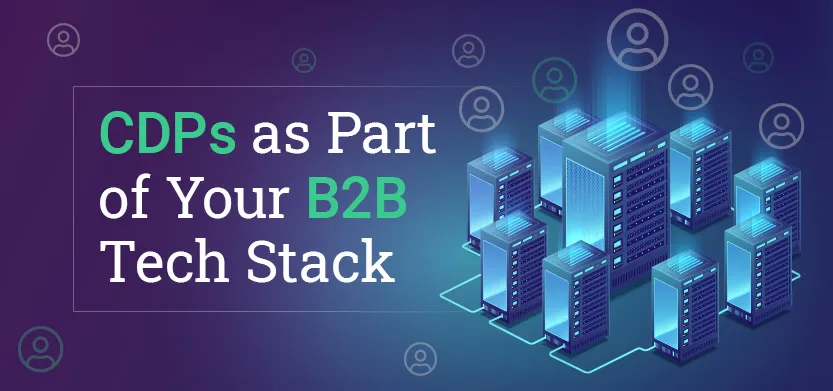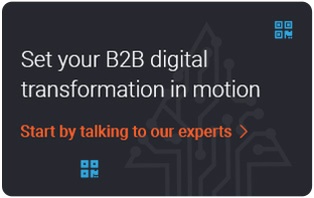
Author
Laura Meshen
, Content Marketing Specialist
Posted in Software & Development
April 8, 2021
CDPs as part of your B2B tech stack
Customer Data Platforms (CDPs). Where do they fit into your B2B tech stack? Many enterprise business marketers have high hopes that a CDP will solve their data problems. In reality, CDPs complement, not replace, other martech systems, according to this Treasure Data survey. Read on to find out how a CDP can fit into and complement your existing tech stack.
Customer Data Platforms — where do they fit into your B2B tech stack?
Often, we hear B2B and enterprise business leaders complain that they feel they are lagging behind in terms of adopting best-in-class technology.
“We need to innovate and find inspiration in other leading industries, but struggle to implement new tech due to the changes it will require of business operations.” - Traditional B2B and manufacturing marketers
 As a result, many B2B organizations are stuck reusing decades-old practices. Those practices have built your business to what it is, so why push to change it? Simple: Your customers demand it.
As a result, many B2B organizations are stuck reusing decades-old practices. Those practices have built your business to what it is, so why push to change it? Simple: Your customers demand it.
Your customers are seeing the evolution of technology and the way it is changing their user experience in the B2C space. Now they want that experience in their work lives. A fluid, seamless customer journey built just for them. Or at least that’s how they want it to feel.
How do you get there? Use your data. All of it. From all of your systems and applications. Harness the power of refined data to build the best customer experience you can for your B2B clients. But how?
The first step is creating an open attitude to adopting the new technologies hitting the market. These tools can make a significant impact on your business. Organizations should not shy away from these new opportunities simply because “that’s not how it’s been done in the past”.
What B2B organizations also need to consider is how those new technologies will talk to each other. Siloed data is next to useless. If it takes too much effort to get the data out of those silos and usable to your marketing and sales teams, is that new tool even worth the investment? Enter the customer data platform.
“CDPs apply specialized technologies and pre-built processes that are tailored precisely to meet marketing (and sales) data needs. This new approach allows a faster, more efficient solution than general-purpose technologies that try to solve many problems at once”. – CDP Institute
When it comes to customer data technology, Customer Data Platforms (CDPs) were created as a response to data-driven marketers looking to make customer data more actionable and accessible. Traditional methods for collecting data were not purpose-built for generating omnichannel personalized customer experiences at scale. Today’s customers demand a more targeted, personalized approach, however, many B2B companies are still stuck using the wrong tools for the job.
So, how will a CDP fit into your existing marketing tech stack? Let’s take a look at some of the technologies you might currently have in place and discuss how a CDP will fit with them and improve your marketing efforts.
Customer relationship management systems
How is a CDP different from CRM systems like Salesforce, Pipedrive, Microsoft Dynamics or HubSpot?
CRM systems were designed to capture personal interactions with a customer. They are a great source for capturing data and organizing customer outreaches which makes them an important and valuable data source. Although constantly evolving, these systems were never designed to import large volumes of data from a variety of systems, nor are they designed to unify a single view of customers from across all customer-facing systems. The data structures in a CRM are designed to facilitate those important customer sales-related interactions, whereas CDPs are constructed with scalable, personalized data-driven marketing purposes in mind. A good CDP should integrate with your CRM system, augment its value, and round out the insight you need.
Data management platforms
Aren’t DMPs (Data Management Platforms) and CDPs kind of the same?
Put simply, the answer is no. DMPs do a great job of streamlining marketer’s effectiveness in digital ad channels. They focus on anonymous audiences and look-a-likes and less on known customers and offline data sources. CDPs are able to leverage data that exists in a DMP and help marketers do more by building a unified customer profile from the data in the DMP and other integrated systems, including non-anonymous data.
| DMPs | CDPs |
|
|
Enterprise data warehousing
We have an internal Enterprise Data Warehouse (EDW). How does a CDP complement what we’ve already invested in?
EDWs came into popularity during the 1990s and are still used by large, enterprise B2B organizations today. EDWs are designed primarily to support additional analysis and reporting, not direct customer interactions. Generally, the data in an EDW is updated daily, weekly or even monthly.
CDPs usually ingest data in near real-time and make it available quickly if not instantly. A good CDP leverages data that exists in your internal data warehouse and makes that data more accessible, predictive and actionable. A CDP does additional processing to make the data immediately usable for the non-technical professional, while a data warehouse does not.
Data warehouses
- Focused primarily on offline/ transactional data and not digital data sources and use cases
- Not meant for personalization at scale
- Not meant for automated machine-learning model development
- Great for custom deep-dive analyses and general reporting
- Can be an excellent source of clean, assembled data if done well
- Customer segmentation is not self-serve
- Difficult to access without a coding background
- Great data source to feed CDPs for data-driven marketing purposes
- Not designed for multi-channel marketing and sales campaign orchestration/revenue attribution
How does what I’m building internally differ from what CDP partners are offering?
Most CDPs are built using common technologies that your company may already own or could buy for itself. The main difference is that CDP partners have added connectors for common source systems, data preparation flows, and identity resolution processes. Your company would need to build those for itself or identify, purchase, learn, deploy, and manage a collection of commercial products that do the same things. This would almost always take more time, cost more money, present a significant risk of failure, and be harder to maintain than a CDP. It would also give marketers less control over the data that they desperately need.
At the end of the day, a customer data platform, integrated into your B2B martech stack will refine your data and build unified 360° customer profiles that you can use to precisely target your sales and marketing campaigns. A CDP relies on your other sources of data, compiling it and giving your marketers the information they need to scale and grow your business.
If you are considering a CDP as part of your B2B digital transformation, our team would love to talk with you and answer any questions you might have. Reach out to us today to get your questions answered and help solve your data challenges.

